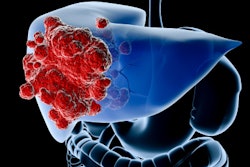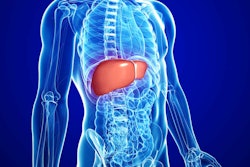Non-liver cancer-specific malignant lesions (LR-M) on CT or MRI are tied to lower overall survival in patients with solitary hepatocellular carcinoma (HCC) undergoing resection, a study published February 27 in Radiology found.
Researchers led by Roberto Cannella, MD, from the University of Palermo in Italy also found that the presence of at least one non-targetoid feature is linked to increased recurrence risk, regardless of LI-RADS category.
“Overall, our results confirm that the LR-M category should be considered in addition to pathology,” Cannella and colleagues wrote.
The Liver Imaging Reporting and Data System (LI-RADS) and histopathologic features provide prognostic information to radiologists for evaluating patients with HCC. However, the researchers pointed out that it’s not well known whether LI-RADS is independently tied to survival.
Cannella and co-authors explored these associations, focusing on LI-RADS categories and features and their potential ties to survival outcomes in patients with solitary resected HCC.
The team included retrospective data from 360 patients with an average age of 64 years in its study. The patients were examined in three institutions and underwent preoperative contrast-enhanced CT and/or MRI between 2008 and 2019.
For the study, three independent readers assessed the LI-RADS version 2018 categories and features. The team also recorded the following histopathologic features: World Health Organization (WHO) tumor grade, microvascular and macrovascular invasion, satellite nodules, and tumor capsule.
%{[ data-embed-type="image" data-embed-id="65de0b6653880ec67b8b456e" data-embed-element="span" data-embed-size="640w" data-embed-alt="Images in a 55-year-old male patient with a history of hepatitis C virus-related cirrhosis and a 45-mm hepatocellular carcinoma (HCC). Axial (A) precontrast and (B-D) contrast-enhanced CT images in the (B) hepatic arterial, (C) portal venous, and (D) delayed phases show lesion (arrow in B) with rim arterial phase hyperenhancement categorized as LI-RADS category LR-M. (E) Photograph of resected specimen shows a poorly demarcated HCC. (F) Photomicrograph (hematoxylin-eosin stain) reveals a poorly differentiated HCC with microvascular invasion (arrows). Scale bar in F = 600 µm. Intrahepatic recurrence was observed at 14 months after resection. Image courtesy of the RSNA." data-embed-src="https://img.auntminnie.com/files/base/smg/all/image/2024/02/2024_02_27_Radiology_liver_images.65de0bd098047.png?auto=format%2Ccompress&fit=max&w=1280&q=70" data-embed-caption="Images in a 55-year-old male patient with a history of hepatitis C virus-related cirrhosis and a 45-mm hepatocellular carcinoma (HCC).<br>Axial (A) precontrast and (B-D) contrast-enhanced CT images in the (B) hepatic arterial, (C) portal venous, and (D) delayed phases show lesion
(arrow in B) with rim arterial phase hyperenhancement categorized as LI-RADS category LR-M. (E) Photograph of
resected specimen shows a poorly demarcated HCC. (F) Photomicrograph (hematoxylin-eosin stain) reveals a poorly differentiated HCC with microvascular invasion (arrows). Scale bar in F = 600 µm. Intrahepatic recurrence was observed at 14 months after resection. Image courtesy of the RSNA." data-embed-width="1800" data-embed-height="1200" ]}%
The group found that on CT and MRI, the LR-M category in LI-RADS was significantly tied to increased recurrence risk. This included hazard ratios (HR) of 1.83 for CT (p = 0.001) and 2.22 for MRI (p < 0.001). Additionally, LR-M categorization was tied to increased risk of death independent of histopathologic features. This included HRs of 2.47 for CT (p < 0.001) and 1.8 for MRI (p < 0.001).
The researchers also reported that the presence of at least one nontargetoid feature on imaging was linked to an increased recurrence risk of recurrence. This included HRs of 1.8 for CT (p < 0.001) and 1.93 for MRI (p < 0.001). The same trend went for increased risk of death on CT independently of histopathologic features, with an HR of 1.51 for CT (p < 0.010).
Finally, the team found that in matched samples recurrence was tied to the presence of at least one nontargetoid feature on imaging. This included HRs of 2.06 for CT (p = 0.02) and 1.79 for MRI (p = 0.048).
The study authors suggested that based on their findings, nontargetoid features are important prognostic features that should be considered in refining LI-RADS as a prognostic tool, “especially for LR-5 observations.”
In an accompanying editorial, Nikolaos Kartalis, MD, PhD, and Aristeidis Grigoriadis, MD, PhD, from Karolinska University Hospital in Stockholm, Sweden, wrote that expanding and refining the use of LI-RADS for prognostic purposes can make way for imaging information to have a greater impact on patient management.
“Further studies confirming the results presented by Cannella et al are necessary to solidify this expanding role of LI-RADS,” they wrote.
The full study can be found here.




















